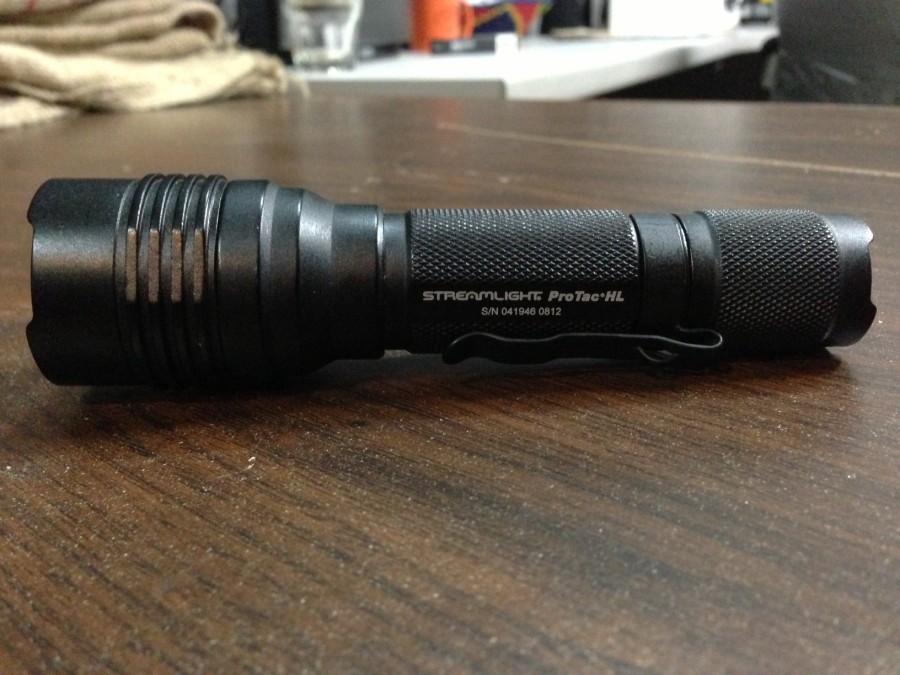 A couple of months ago, I took a class that incorporated some low light training. And by low light, I mean a pitch dark range with only your flashlight to identify shoot/no shoot targets. The instructor was Steve Gilcreast of the SIG Sauer Academy (who’s been a featured weapons expert on a couple of Top Shot episodes). Steve has over 12 years of experience in law enforcement, much of it on a SWAT team, so he knows a thing or two about the tactical use of a flashlight to clear a potentially dangerous scene. Steve talked about what he looked for in a flashlight . . .
A couple of months ago, I took a class that incorporated some low light training. And by low light, I mean a pitch dark range with only your flashlight to identify shoot/no shoot targets. The instructor was Steve Gilcreast of the SIG Sauer Academy (who’s been a featured weapons expert on a couple of Top Shot episodes). Steve has over 12 years of experience in law enforcement, much of it on a SWAT team, so he knows a thing or two about the tactical use of a flashlight to clear a potentially dangerous scene. Steve talked about what he looked for in a flashlight . . .
Durability, size, brightness, and momentary activation. With respect to brightness, Steve said that while he used to recommend flashlights in the 150-200 lumen range, with the advent of more powerful torches, he now suggests getting as bright a unit as you can with 200 lumens being your absolute floor.
He also made the point that if you’re using a flashlight to clear a room (or your house, if you are investigating the proverbial “bump in the night”), you’re probably not going to want to walk around with it powered on. All that does is give a potential bad guy an easy target to shoot at.
Instead, he recommended selecting a flashlight that has a momentary activation switch that fires the flashlight at its brightest mode. A quick burst of light is enough to identify any targets, then you move and flash it again in another direction. Along these lines, he’s not a fan of multi-mode flashlights, particularly those that require multiple quick presses to switch from high to low to strobe to whatever. There’s too great a chance that you could accidentally activate the wrong mode, so Steve prefers a light that has a single mode for tactical uses.
After that class, I took an inventory of my flashlights. My daily carry light is a Streamlight ProTac 2L which was reviewed by Zack Pike back in August. 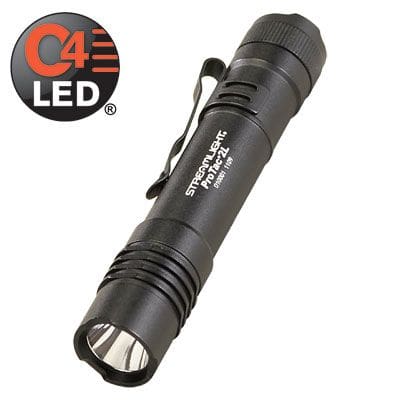
Following Foghorn’s post on the Surefire P2X Fury, I picked up one of those. Initially, I liked the low/high mode that the original P2X featured. I figured I could use the battery conserving low mode for things like navigating my breaker box and the high mode if I ever needed to hunt down a bad guy or illuminate something a long way away. That, of course, was before my aforementioned class. I quickly realized that the P2X in its current format wasn’t going to work for me in a defensive capacity. Apparently, Surefire realized this too, as they came out with new single mode models shortly after Foghorn’s review.
So, I relegated my P2x to secondary duty as a weapon-mounted light for my Mossberg 930, and began the search for a new, powerful tactical flashlight. I obviously first considered the Surefire P2X Tactical model, but at a price of around $125 (now you can find them for about $110), I decided to look around a little more. My search brought me to the Steramlight ProTac-HL which, at $65, offered 20% more brightness (600 lumens versus the P2x’s 500 lumens) at nearly half the price.
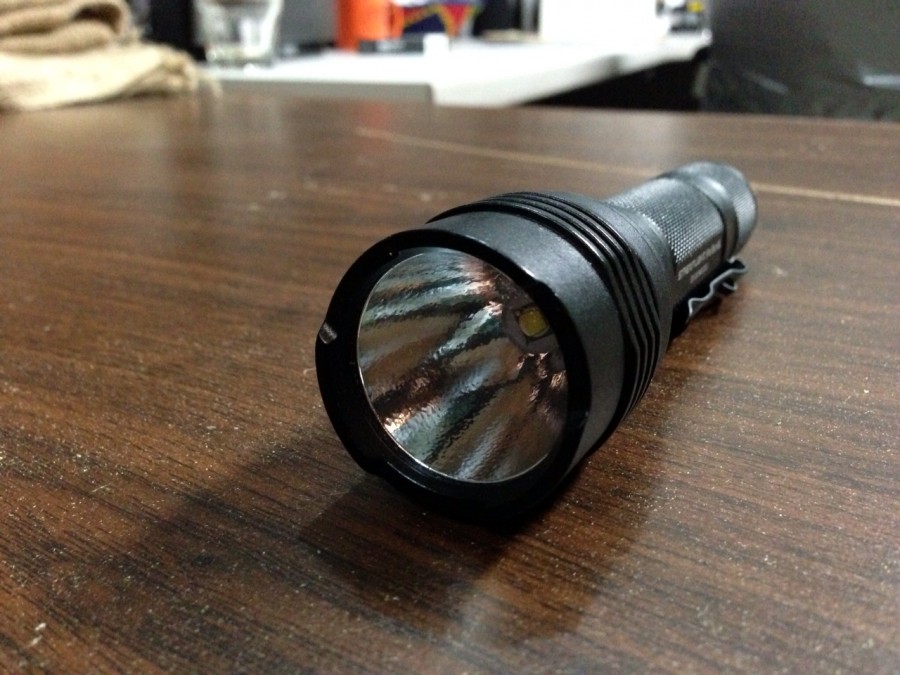 Now, when someone offers something at half the price of the other guy, my Spidey sense starts to tinle. A price disparity that great has to come at some cost…but damned if I could figure out what it is. The Streamlight is made of a durable aluminum housing and includes a clip that’s great for keeping your flashlight right where you want it. It certainly seems to be as rock solid as the more expensive Surefire. I wanted to see how it worked, so I did some testing both for area illumination and for long distance.
Now, when someone offers something at half the price of the other guy, my Spidey sense starts to tinle. A price disparity that great has to come at some cost…but damned if I could figure out what it is. The Streamlight is made of a durable aluminum housing and includes a clip that’s great for keeping your flashlight right where you want it. It certainly seems to be as rock solid as the more expensive Surefire. I wanted to see how it worked, so I did some testing both for area illumination and for long distance.
This first set of pictures was shot in my very messy cellar using only the flashlights for illumination. The 500 lumen Surefire is on top, the Streamlight on the bottom.
I tried to shoot these such that I illuminated the same point with both lights – close, but not perfect. There doesn’t seem to be much difference between the two in terms of area illumination – certainly the 20% more promised lumen level is not readily apparent to the eye. That said, both lights did a bang-up job.
The next shots were taken outside. I’ve kept these two at full size as the smaller versions are hard to make out. The barely illuminated pine trees in the distance are 100 yards or so away.
First the 500 Lumen Surefire: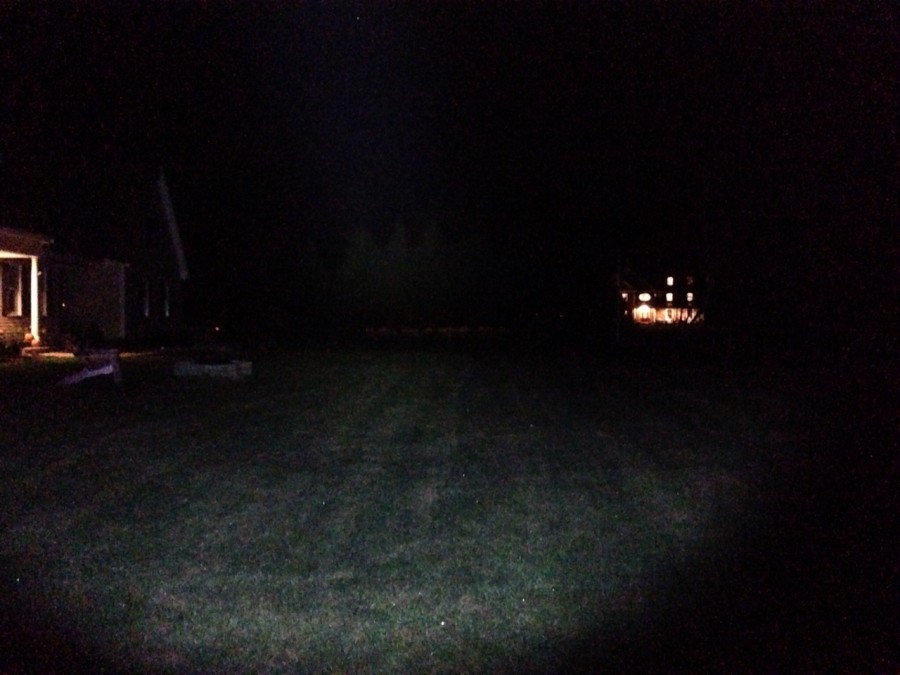 Then the 600 Lumen Streamlight:
Then the 600 Lumen Streamlight: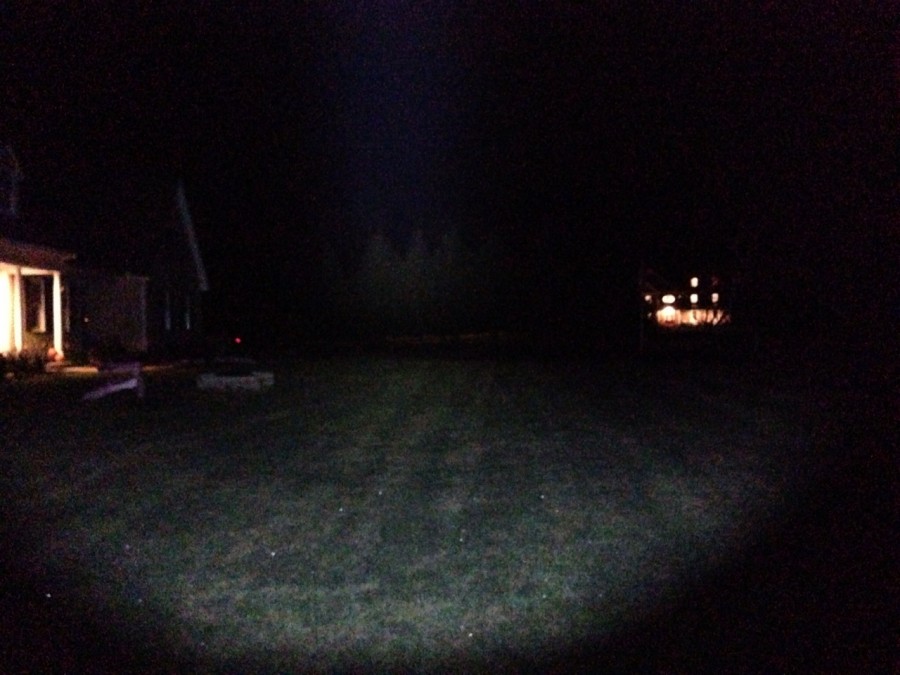 While the difference is slight, you can start to see the extra power of the Streamlight does make a difference illuminating a target 100 yards away.
While the difference is slight, you can start to see the extra power of the Streamlight does make a difference illuminating a target 100 yards away.
Finally, I tested both lights on my kids’ swing set about 50 yards out. Again, the 500 Lumen Surefire is first:
Then the 600 Lumen Streamlight:
Yes, I know the resolution sucks, but I was holding a flashlight with one hand and my iPhone with the other in below freezing weather, so pardon me for not breaking out my Nikon.
What’s apparent, however, is that this last set of comparison shots really highlights the difference. The extra 20% brightness produced by the Streamlight enabled the iPhone to get a better lock on the target and produce a marginally clearer picture that was better lit. The Streamlight, then, is clearly the winner here.
A bright flashlight is a good thing to have, but it ain’t worth squat in a gunfight if you can’t use it tactically. And let’s face it, you want to know how it would perform in a gun fight. I noted earlier that the ideal tactical flashlight is a single mode with a momentary on capability. At the same time, some users might like the ability of the flashlight to have a low brightness mode if they planned to use it for an extended time.
Surefire solves this problem by simply having you buy two flashlights. One like the regular P2X will do Lo/Hi toggling with each activation of the switch. The Tactical version will give you that single high brightness level with each click.
But Streamlight decided to take a different approach. The ProTac HL has user-selectable modes that you can set on the flashlight. Options are high/strobe/low (the standard Streamlight setting good for those who want to run their own Discotheques), high only, and low/high.
The user selects the mode of choice using Streamlight’s TEN-TAP programming system. Basically, you rapidly tap the switch 9 times and then hold it a tenth time. Each time you go through this procedure, you cycle to the next mode. The system is pretty foolproof. Once set, it’s highly unlikely that you would ever accidentally change the mode – once set, it stays set.
This approach makes the ProTac HL a very versatile light that enables you to customize it for your mission.
The only real nit that I have to pick with the ProTac HL is its size. Whereas my Protac 2L is about as thick as one of those thin magic markers, the HL is a lot bulkier. If I’m wearing pants of a more tactical nature with dedicated pockets for flashlights, etc, I can carry it easily, but in my everyday jeans or — even worse — the Dockers I usually wear to work, I think I’m going to stick with my 2L and leave the HL by the bedside. The Surefire is no smaller, so the fact is that if you want a light with that kind of brightness, current technology means the slightly larger form factor.
All that said, the Streamlight beats the pants off of the competition here. It’s less expensive, brighter, more versatile in terms of operating modes and has a belt clip to boot. My only concern would be whether the extra complexity of the TEN-TAP system might ultimately lead to reliability issues. Time will tell on that, but given the track record of other Streamlights I’ve owned, I’m not all that worried.
Ratings (out of five stars):
Design: * * * * *
Short, belt clip, a little on the thick side, but that’s a function of its power. Pretty close to as perfect as today’s state of the art in flashlight technology gets.
Durability: * * * * *
Waterproof and shockproof. Granted, I haven’t had the urge to forcefully smash a $70 flashlight on the ground or try running it over with my F150, but it has been dropped onto the concrete a couple of times with no ill effects. Based on my experience with the 2L, I expect the black to wear off in some places with use, but no dings here for that.
Usability: * * * * *
The TEN-TAP system makes this the flashlight for everyone. Whatever you want to do with it, you can. And you can change your mind and choose a different operating mode any time.
Value: * * * * *
Did I mention this thing is only $65? It has more features and is brighter than the competition and beats the pants off of them in price. What’s not to like?
Overall Rating: * * * * *
It’s hard to hand out five star ratings because nothing is really perfect. But I can’t think of one thing to ding this light on. Sure, I wish it were thinner, but it’s not fair to subtract a star just because the light doesn’t violate one of the laws of physics (based on current technology). Maybe in a few years when manufacturers have figured out a way to get more brightness in a thinner form factor, this light will not longer be 5 stars, but as we approach the end of 2012, this is as close to state of the art as you’re going to get.

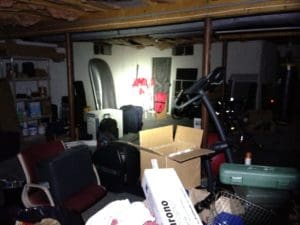





I have one these that stays in my truck. It’s a great light for the price. If it was rechargeable, it would replace the Fenix TK11 I carry at work.
Surefire lights are waaaaay over prices IMO….Streamlight an Fenix are the way to go!!!
Taking good photos that illustrate the comparative brightness of flashlights is a bitch. It’s almost impossible with a point-and-shoot or camera phone: they automatically extend the exposure until they get the image brightness they’re programmed for. A fully programmable/manual camera can do it, although the results aren’t always worth the effort.
There are camera apps for smartphones which give you better control over exposure, but they’re limited. Too much of how phone cameras work is automated beyond the ability of third party apps to control.
Disagree that you can’t get good flashlight shots with many point and shoots. Most compact digicams of good quality (priced at $150 on up) have at least one shooting mode that lets you lock in shutter speed, aperture and ISO. It can be annoying to do so but it’s generally possible with some messing around.
I bought one of the Streamlight HL models a couple of months ago, was favorably impressed, and bought two more (one for my vehicle, one for a spare) before they could jump the price. No problems at all so far; great lights.
Once you get to this level of light output, though, there is a very real possibility of flash-blinding yourself in many indoor environments. Trigger it in a small dark room with white- or light-colored walls, and YOUR eyes can be shut-down from the glare.
As an academy instructor charged with staying abreast of these things, we have found no real-world experiences to back up this widely held belief. In both life-speed training scenarios, i.e., shoot house, etc., and real-world scenarios, (debrief on LE entries as well as sand-box participants) we have not found any instances in which the extra light provided by these newer devices caused any ill effect on anyone other than those on the receiving end of the action. In every instance we have looked at, more light was a positive rather than a negative.
I used the word “possibility” as I didn’t know the extent of the potential problem outside of my own personal experience, but I can tell you it was very unpleasant when I did it to myself, and it caused me to pause briefly in what I was doing (not a good thing in certain situations). Glad to hear it has been considered and researched, although I’m curious about the procedure for debriefing those folks who failed to survive their “real-world scenarios” (and how their lights/usage may have contributed to the poor outcome).
Perhaps this is a sign that it’s time for me to add some professional training in this area. Thanks for taking the time to respond.
Good review, And I like the beam shots. The max throw on the Streamlight is rated at 245 meters, according to Battery Junction. It looks to me that you just reviewed the current value and performance winner.
I carry an Olight T25 LED. It’s all metal, small, runs on 2 AA batteries and gives you 250 lumens. It has accidentally gone through two complete washer and dryer cycles in my jeans pocket. No problem. When I upgrade it will be a more powerful Olight.
I was about to speak wonders of my Olight M20, M21, and M20s. The removable strike bezels are pretty sweet, and my M20 Warrior has access to an instant strobe from the off position.
I have a Surefire M6 Guardian, but its obsolete because it is incandescent. That sucks because I got it for $285 on EBay around 6-7 years ago.
My next light will probably be an Olight M31, because I managed to fry the LED engine in my old one due to a combination of heat sink failure and operator error. I like having 700 meters of throw.
I have an old Surefire too. At 120 lumens it’s not worth replacing the burnt out bulb or even upgrading to LED. I was thinking of the Olight S35 or S65 since they run off AA batteries. I like strike bezels but it would tear a hole in my pocket and may get me busted in NYC.
Mini maglight with LED conversion. Why? Because I’m too cheap to spend that kind of cash on a flashlight. I suffer thru more power failures than gun fights and having a cheap, reliable source of long term light is more valuable to me than being able to light up the tree line a 100+ yards away.
I haven’t soldiered in a long time, engaging past my back door would no doubt get me in trouble with the DA.
The downside of Maglite LED conversions: the batteries last so damn long that they swell and/or leak and get stuck in the tube. This is especially true with D-cell Maglites. Ask me how I know. (Sigh)
Moral of the story: change the batteries in LED Maglites yearly whether they need it or not. I do mine on Thanksgiving, since there’s plenty of dead time for maintenance tasks.
If this does happen, and you’ve used batteries from one of the big 3 brands, swap the regular bulb back in and send it off to Maglite for replacement. They will take care of filing the claim against the battery maker for you. Even if you get the batteries extracted from the tube there’s a good chance you’ll have issues with the switch, and as the kids say on the Internet “ain’t nobody got any time for that!”
I had a AA Duracell rupture in my Olight T25. One day it was working, the next day nada and it was a mess inside. Now I know why. Took a bit of doing to get the battery out and remove the crud and corrosion but I got it working again.
It’s a particular problem for lights that get left in vehicles. Battery temps can reach 140F or more in the summer, which you mostly don’t notice because by the time you need it that evening, the light has cooled down.
I’ve become more of a fan of small lights that run off of cr123 lithium cells for this reason. The batteries are reasonably priced if you buy them online in 12-packs, and they work a lot better in this application than alkalines.
You can’t have a kubotan in NYC?! Good Lord, what is the nation coming to!
The strike bezel is removable for pocket / airline carry. Just FYI.
+1 on Steve Gilcreast.
I took a carbine course with Steve at Sig back in the spring. Highly recommended.
1. If you need Milspec go Sure Fire or Streamlight.
2. Am a lighting junkie who has tested just about everything out there.
3. At present carry a Chinese made light that gives an honest 350 Lumens on an AA battery.
4. Is roughly 4 x 3/4″.
5. Buy them 4 or five at a time for about $16 @ from Deal Extreme.
6. About one in five is defective on delivery.
7. Have sent dozens of these things to various AO’s. Because of their size and power, have gotten lots of thank yous and comments that when it came down to brass tacks, these were the equipment that got the job done. You can usually get AA batteries even in East Jesus.
8. Warning: Daytime, high heat will cause the battery to leak. Folks were taking them out during the day
9. There are several, almost identical competing brands. Performance is identical; reliabilty is not. The Ultrafire G 10 is the best of the lot (#6).
10. Put one in left and right coat pockets, driver and passenger side doors, etc.
11. Have come a long way from advocating use of one’s senses and scorning use of lights, NVG’s and the lot. Daughter says that means I’m getting old.
V/R JWest
JWest: you have a link to that G10 on Deal Extreme? I surfed through 17 pages of Ultrafires and did not see it and the search won’t let me drill down past “Ultrafire”. Who knew there were so many lights by 1 outfit? Thanks for the main review and your comments. Steve
Putting “g10” in their search box brings up these:
http://dx.com/p/uniquefire-g10-cree-xp-e-r5-1-mode-350-lumen-white-led-flashlight-with-strap-1-14500-1-aa-55244?item=6
http://dx.com/p/uniquefire-g10-cree-xp-e-r5-6-mode-350-lumen-white-led-flashlight-with-strap-1-14500-1-aa-55243?item=5
I didn’t see that because I thought he said it was an Ultrafire G10, not Uniquefire.
1. Sorry Steve. Mr. Zimmerman is correct.
2. Did not check the Deal Exrtreme site. What they have listed as Uniquefire is the same style I was talking about.
3. Guess they changed the name.
4. The Ultrafire K-10 were a slightly different design that included a lot of duds. The G-10 is the important part, apparently.
5. Accessed the site through LED Flashlights, AA battery subcategory.
V/R JWest
I recently got an LED Lenser P7 rechargeable with the nifty magnetic charging cradle to live on the wall behind the bedroom door. Very handy for power outages, and the charging cable ends in a USB plug which makes it easy to vehicle-charge during an extended power outage. Quite like it overall as a home utility light.
Cons:
– It does have the complicated Morse-code clicky system to select modes, but fortunately it defaults to full brightness and you have to multi-click it VERY fast to select alternate modes.
– It is not regulated, so brightness will drop with voltage as you deplete the Li-ion battery. This is not a notable issue for the critical first 10 minutes of use at max output.
– Charging indicator is very bright. Had to mask off 99% of it with electrical tape so it wouldn’t light up the bedroom!
I have found that this is ok for general use, but I am less of a fan of hand-held lights for personal defense with every day that goes by. For me, nothing beats a weapon-mounted light with a good switch setup, and even with practice I don’t enjoy shooting pistol with a flashlight-hold technique. Definitely planning an upgrade to one of those Streamlight TLRs that comes with USP rail mounts.
The best flashlights on the market: Malkoff Devices.
http://www.malkoffdevices.com/shop/index.php
I have several of them, but the “Wildcat” will blow away anything Surefire makes.
I own several surefire lights and also own a malkoff wildcat. theyre both awesome flashlights.
+1 on the HL flashlight which I think is a great value. Light is incredible and it has proven to be rugged enough to survive heavy use by everyone in my house. The only knock is that it is a little chunky. BTW, I purchased this light after taking a course with Steve at the Sig Academy in which the value of a powerful light was well demonstrated. +1 on Steve as an instructor too.
Thanks , I have just been searching for information about this topic for a long time and yours is the greatest I have discovered till now. But, what in regards to the conclusion? Are you positive concerning the source?|What i do not realize is in fact how you’re no longer actually much more smartly-liked than you may be right now. You’re so intelligent.
What?
I have two of these lights. One was purchased for me at the mill i work at, the other i bought myself to keep on the nightstand. The programmable low/high setting is great and i can speak for their durability. My work light has survived a 25 foot drop, submerged for about 10 minutes in water, and 2 or 3 trips through the washing machine without a problem. Great product.
That was quite a detailed review. hey, don’t worry about the quality of photographs. My attempt was terrible 😛
Well, ProTac HL 88040 is what I consider the best value for money. Yes, its a bit pricey compared to 2L. But 260L Vs 600L along with some other improvements, justify the price difference – I believe.
Thanks for the time taken to write this, Jim.
Surefire is Assembled in the U.S.A. of foreign and domestic parts. Streamlight is 100% China. Sometimes you have to pay for principle.